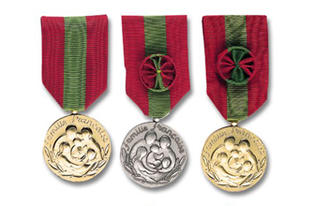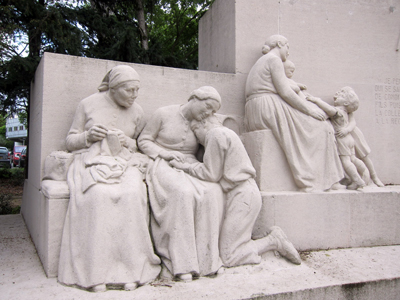An outing for Mother’s Day might be to the Mothers monument in Paris 13th. Some consider the Monument aux Mères Françaises in the eponym park at 21 boulevard Kellermann to be austere and soviet-styled, but we must take into consideration that it was inaugurated in 1938 and thus view it in context of the between the wars depression era. The sculptures laud Mothers after the tragic loss of so many men and boys in the first world war and encourage them to stay at home to care for the family. The monument was renovated in 2013 and the cleaned sculpture is much less sad looking. There are 5 sculpted groups by artists Pierre d’Euville, Henri Bouchard et Alexandre Descatoire. The three texts on the momument are by Albert Lebrun, Edmond Labbé and Victor Hugo. Plants and flowers brighten this little garden in the 13th arrondissement. It is perhaps not the prettiest sculpture from today’s viewpoint, but do you know any other cities that honor their mothers with a monument? In that way French Mothers are honored every day.
The monument was renovated in 2013 and the cleaned sculpture is much less sad looking. There are 5 sculpted groups by artists Pierre d’Euville, Henri Bouchard et Alexandre Descatoire. The three texts on the momument are by Albert Lebrun, Edmond Labbé and Victor Hugo. Plants and flowers brighten this little garden in the 13th arrondissement. It is perhaps not the prettiest sculpture from today’s viewpoint, but do you know any other cities that honor their mothers with a monument? In that way French Mothers are honored every day.
Je pense que le dévouement et l’abnégation des mères française qui se sacrifient pour leurs enfants et particulièrement celles qui de condition modeste se privent et travaillent pour que leurs fils puissent s’élever aux destinées des grands serviteurs de la collectivité ne sauraient plus longtemps rester soustraites à la reconnaissance nationale. — Albert Lebrun, Président de la République
Another way the French honor mothers is the Médaille de la Famille française. Three classes of medals exist: bronze for those raising four or five children, silver for parents of six or seven children, and gold for those with eight or more children. A bronze medal is also granted to widowed mothers of three children whose husbands have been killed in action. The Medal was created in 1920 to encourage repopulating France after WWI. Encouragement was needed as the population was drastically reduced during the war and it took until the 1950s to catch up and start growth again.
Nominations and applications for the medal are made at city hall and yes this medal still exists. France is once again facing decling demographics and so encouragement of motherhood is still on the agenda. Find out more
 Early Mother’s Day celebrations can be dated back to the spring celebrations to honor Rhea or Cybèle the grandmother of the Greek gods and mother of Zeus. Mothering Sunday in the United Kingdom was traditionally a day for people to visit the church where they were baptized, although it now also celebrates motherhood in modern times.
Early Mother’s Day celebrations can be dated back to the spring celebrations to honor Rhea or Cybèle the grandmother of the Greek gods and mother of Zeus. Mothering Sunday in the United Kingdom was traditionally a day for people to visit the church where they were baptized, although it now also celebrates motherhood in modern times.
The modern-day origins of Mother’s Day can be attributed to two women – Julia Ward Howe and Anna Jarvis, who were important in establishing the tradition in the United States. Around 1870, Julia Ward Howe called for Mother’s Day to be celebrated each year. It continued to be held in Boston for about 10 years under her sponsorship, but died out after that.
In 1907, Anna Jarvis held a private Mother’s Day celebration in memory of her mother, Ann Jarvis, in Grafton, West Virginia. In 1908, she played a key role in arranging a church service that attracted 407 children and their mothers. A Mother’s Day International Association was founded in 1912 to promote the holiday in other countries. Mother’s Day has grown increasingly popular since then. Most countries celebrate Mother’s Day. The majority celebrate in May. In France it is the last Sunday of May, this year the 30th, but the largest day for celebration is the second Sunday of May (9th in 2021) which includes the countries of Australia, Canada and the United States. The United Kingdom, Ireland and Nigeria celebrate three weeks before Easter in March. Mother’s Day is an annual public holiday in some countries such as Costa Rica, Belgium (August 15, on the same day as Assumption Day), Georgia (March 3), Samoa (second Monday of May), and Thailand (August 12). Some countries cumulate Mother’s Day with International Women’s Day on 8 March: Albania, Bulgaria, Moldavia, Romania, Serbia. Arab Nations hold Mother’s Day on the Spring Equinox…



